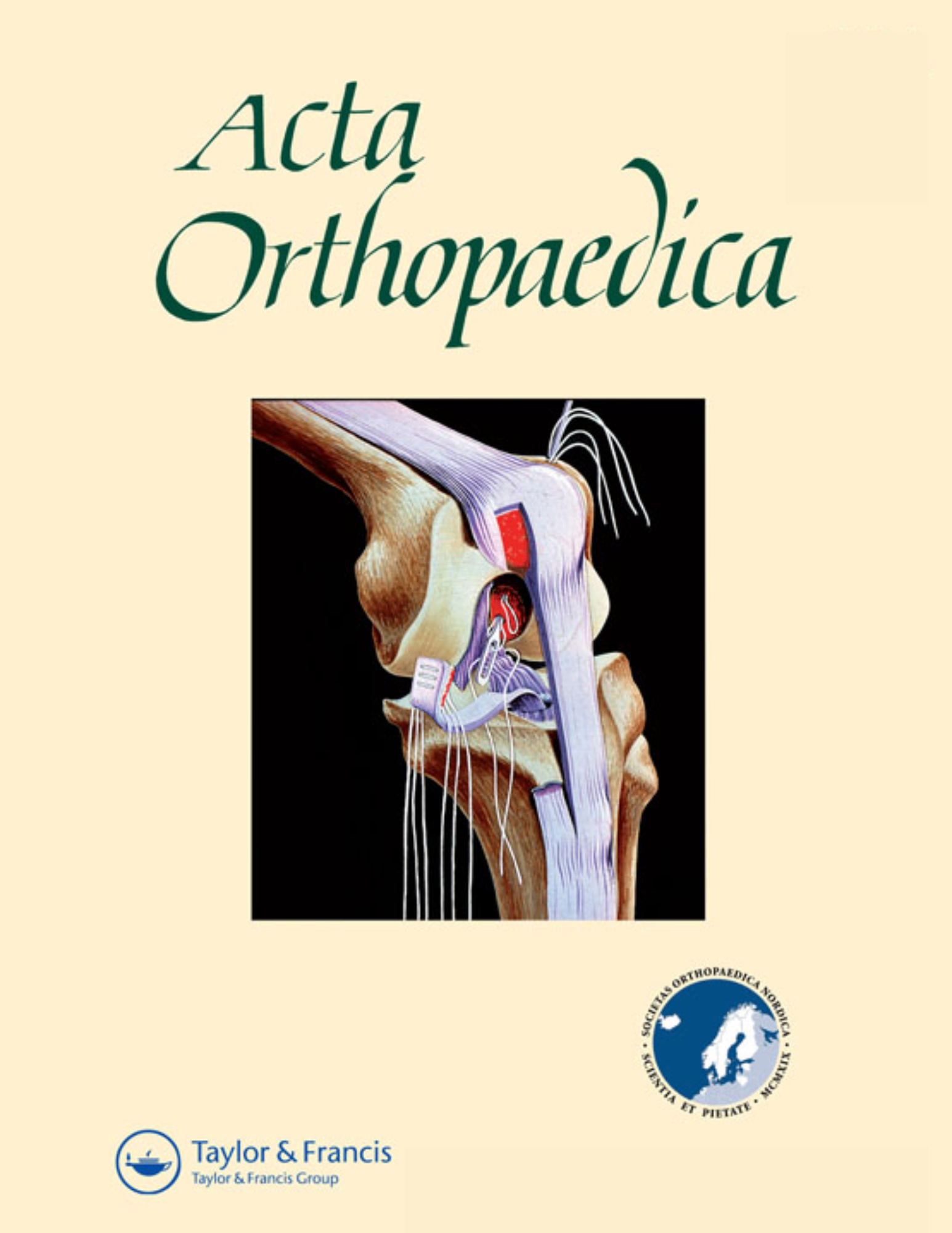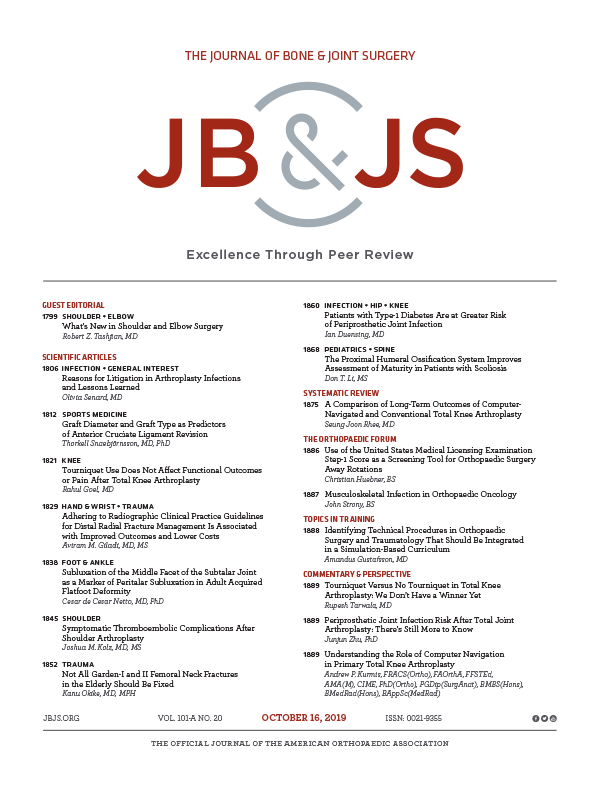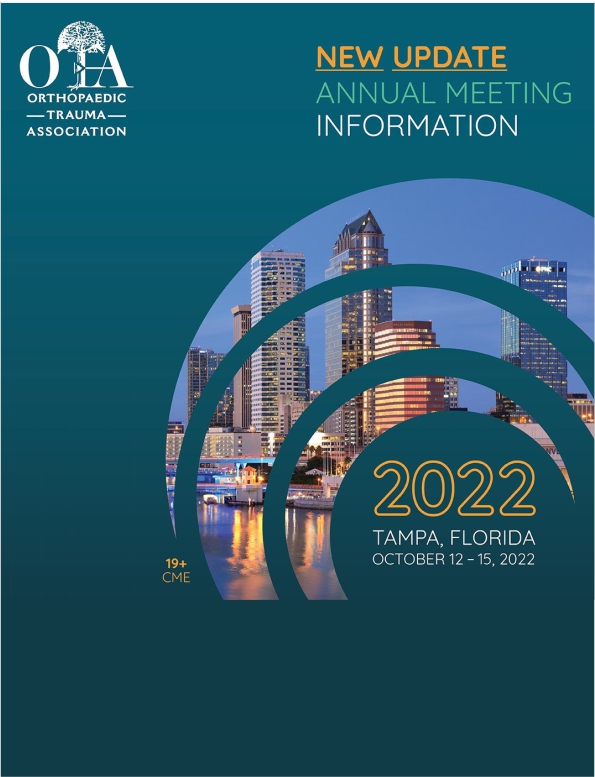PeerView
You are viewing the most viewed ACE Reports by Orthopaedic Resident/Interns over the last 30 days in all specialties.
Displaying
100%
①
Synopsis:
Four hundred and thirty eight patients undergoing inpatient primary TKA at 11 centers were randomized to receive 4 mg (n = 146), 8 mg (n = 147), or 16 mg (n = 145) of intraoperative IV dexamethasone, all within an identical multimodal analgesia/anesthesia protocol including neuraxial anesthesia, adductor canal block, periarticular injection, and standardized oral analgesics.The primary outcome was cumulative opioid consumption in oral morphine milligram equivalents (MME) over the first 48 hours postoperatively.Secondary outcomes included daily opioid use to 7 days, pain at rest and with activity, nausea scores, vomiting episodes, sleep duration, postoperative day 1 (POD1) glucose, length of stay, and 90-day complications.Outcomes were assessed with a 7-day patient diary and chart review through 90 days.Overall, the results of the study revealed that 16 mg IV dexamethasone modestly reduced early opioid consumption (particularly vs 8 mg), improved pain at rest and reduced vomiting within 24 hours, but increased POD1 glucose in a dose-dependent fashion without increasing short-term complication rates. These findings suggest...
Read More »
Level 1 RCT
①
Synopsis:
One hundred and sixteen patients with displaced femoral neck fractures were randomized to receive hemiarthroplasty via the anterior approach (AA) (n=58) or the lateral approach (LA) (n=58).The primary outcome was function at 6 weeks on the Barthel-20 Index.Secondary outcomes included EQ-5D, pain (VAS; plus 5-day opioid use), length of stay (acute and to rehab discharge), complications (medical and implant-related), readmissions/ED visits, and mortality.Outcomes were assessed at 2, 6, 12, and 24 weeks.Overall, the results revealed no between-group differences for the primary outcome (both groups mean 15.8 at 6 weeks; P=0.98) or for secondary patient-reported outcomes, resource use, complications, readmissions, or mortality; operative time was modestly longer with AA and cement mantle quality was worse. In short, AA...
Read More »
Level 1 RCT
①
Synopsis:
12 randomized controlled trials (788 patients) comparing the use of a minimally invasive medial midvastus approach (MMV-TKA) versus the standard medial parapatellar total knee arthroplasty (MP-TKA) were included in this systematic review and meta-analysis.Outcomes of interest included the Knee Society Score (KSS), knee pain on a Visual Analog Scale (VAS), knee function on a Normalized Function Scale, knee range of motion (ROM), time to straight leg activity, incidence of loose outboard support belt use, operative time, length of stay, blood loss, and incidence of postoperative complications.KSS scores, VAS pain scores, and knee joint flexural activity at 3 months, and days of straight leg raises were significantly better in the MMV-TKA group.Operative time was significantly shorter in the MP-TKA group. All other outcomes...
Read More »
Level 1 Meta Analysis
②
Synopsis:
74 patients scheduled for total knee arthroplasty were randomized to undergo the procedure with or without patellar resurfacing.The purpose of this study was to compare short-term functional performance measures, and mid-term patient reported outcome measures of pain, satisfaction, and disease-related quality of life between groups. No significant differences...
Read More »
Author verified Level 2 RCT
②
Synopsis:
76 patients with Dupuytren's contracture and a palpable nodule were randomized to one of four groups; 0.25mg collagenase clostridium histolyticum (CCH) injection, 0.40mg CCH injection, 0.60mg CCH injection, or placebo injection.Patients were assessed over 8-week follow-up nodule size and hardness, pain, patient satisfaction, and investigator-rated improvement.After 8 weeks, reduction in nodule size was significantly greater in the 0.40mg and 0.60mg CCH groups compared to placebo, and reduction in nodule hardness was significantly greater in the 0.25mg, 0.40mg, and 0.60mg CCH groups compared to placebo. Composite responder rate...
Read More »
Level 2 RCT
Synopsis:
80 patients scheduled for primary total hip arthroplasty were randomized to surgery completed through either a lateral approach or a posterior approach.Primary outcomes were cup inclination and anteversion, as well as the number of cups placed outside of Lewinnek "target zone" (40+/-10deg inclination; 15+/-10deg anteversion). While results for...
Read More »
RCT
①
Synopsis:
One hundred and nineteen patients with insertional Achilles tendinopathy were randomized to received extracorporeal shockwave therapy with eccentric exercise (ESWT +EE) (n=58) or eccentric exercise (EE) and sham therapy (n=61).The primary outcome was function measured by the Victorian Institute of Sports Assessment-Achilles questionnaire (VISA-A).Secondary outcomes of interest included pain scores, the Foot and Ankle Outcome Score (FAOS), the Short Form Health Survey (SF-12), recurrence and failure of treatment.Both groups demonstrated significant improvements from baseline.No differences in the VISA-A, FAOS or SF-12 were found at any time point between groups. The EWST+EE group...
Read More »
Level 1 RCT
Synopsis:
Fifty patients undergoing total hip arthroplasty for femoral neck fractures were randomized to either the direct anterior or lateral approach.Outcomes of interest included perioperative and postoperative short-term clinical outcomes such as incision length, blood loss, and neuropraxia.Radiological (e.g., cup inclination and anteversion) and functional outcomes (Harris Hip Score and Timed Up and Go) were also assessed at 6 months. Both the direct...
Read More »
Conference Report
①
Synopsis:
Ninety patients with intra-articular hip disorders, mainly osteoarthritis, were randomized to receive fluoroscopy-guided intra-articular steroid injection via the anterior approach (n=30), the anterolateral approach (n=30), or the proximal anterolateral approach (n=30).The primary outcome was successful injection in a single attempt.Secondary outcomes included pain during injection (VAS), radiation exposure, complications, and short-term functional improvement measured by the modified Harris hip score (mHHS).Outcomes were assessed at baseline and 2 weeks post-injection.Overall, the results revealed no significant differences between approaches in single-attempt success, VAS pain, radiation exposure, or mHHS improvement. The study concludes...
Read More »
Level 1 RCT
①
Synopsis:
The PREPARE Trial was a cluster-randomized, crossover trial part of the PREP-IT program, which compared alcohol-based anti-septic solutions of iodine povacrylex vs.chlorhexidine gluconate in operative fracture patients.THE PREPARE Trial included a total of 8485 patients who underwent fracture fixation: 1700 patients with open limb fractures and 6785 with closed lower-limb or pelvic fractures.Randomization occurred at the hospital level.The primary outcome of interest was the incidence of surgical-site infection, which included superficial incisional infections within 30 days and deep incisional or organ-space infections within 60 days post-surgery.Secondary outcomes included unplanned fracture-related reoperations and serious adverse events.The iodone povacrylex group (77/3205; 2.4%) had a lower incidence of surgical site infections compared to chlorhexidine (108/3272; 3.3%) in closed-fracture patients [OR, 0.74; 95% CI, 0.55 to 1.00; p=0.049].The rates were similar in open-fracture patients between the iodine (54/3272; 6.5%) and chlorhexidine (60/3272; 7.3%) [OR, 0.86; 95% CI, 0.58 to 1.27; p=0.45].In the closed-fracture group, 5.5% in the iodine group and 5.9% in the chlorhexidine group underwent unplanned reoperations [OR, 0.96; 95% CI, 0.77 to 1.20].In the open-fracture group, the figures were 16.1% for iodine and 14.5% for chlorhexidine [OR, 1.16; 95% CI, 0.87 to 1.54]. The results of...
Read More »
Level 1 RCT




 LOGIN
LOGIN










